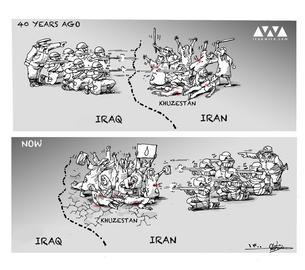For weeks now, the people of Khuzestan province have been suffering due to disastrous water shortages that have left farmers without a means of subsistence, families without adequate drinking water, and whole shoals of fish dead on the dried-up riverbeds. This week’s protests come against a backdrop of 40 years of discrimination and official indifference on the part of the Islamic Republic, despite the fact that this fertile and history-rich province has enough oil reserves by itself to cover most of the costs of the other 30.
Iran’s Management and Planning Organization, like all other high- and low-level government institutions, are well aware of the situation on the ground in Khuzestan. Citizens in this marginalized province are losing what little spending power they have day by day: an issue that since last Friday has finally come back to the fore.
By almost all available criteria, Khuzestan is one of the poorest and most deprived provinces of Iran. This report examines data held by the Management and Planning Organization and other official bodies in Iran to examine the various areas in which Khuzestanis are losing out, through no fault of their own.
Khuzestan’s Politics, Society and Culture
Human capital: The Management and Planning Organization ranks Khuzestan 18th out of Iran’s 31 provinces in terms of human capital. Ethnic discrimination and a lack of opportunity, from school age onwards, are among the contributing factors.
Security: High rates of poverty, unemployment, discrimination, underdevelopment and injustice in Khuzestan have put the province in a critical security situation. These factors have led to the aggravation of separatist and anti-centralist tendencies.
More than 75 percent of Arabs in Khuzestan believe that central government discriminates against them. In addition, 71 percent believe that the Arabs of Khuzestan face worse levels of poverty and 81 percent say they are more likely to be unemployed.
Officials in the Islamic Republic have historically cited Saudi Arabian intervention and “Wahhabism” as a counter-security factor. This is the same pretext on which protests in Khuzestan are often suppressed.
Demographic imbalance: An unequal distribution of water and arable land has led to economic but also development disparities in Khuzestan. Some 75 percent of the urban population lives on the western side, and only about 25 percent to the east.
Emigration: Drought, near-unbearable temperatures, pollution from factories and industrial zones, a lack of opportunity to nurture talent, a lack of job opportunities, and non-investment have prompted at least 200,000 people to emigrate from Khuzestan in the last five years. This makes it the most-emigrated-from province in Iran.
Concentration: In Khuzestan, most major facilities, from hospitals to industrial zones, are concentrated around the capital of Ahvaz. Bavi County, the closest county to the capital, is somehow still the most deprived in the province.
Evacuation of oil-rich cities: A significant number of cities in the oil-rich regions of Khuzestan, from Lali to Omidiyeh, are dependent on oil extraction for income. No step has been taken to build sustainable housing or infrastructure in these areas that did have oil and natural gas as the driving force behind it. If oil exports remain slow, these cities could end up as ghost towns.
Child marriage: According to the Statistical Center of Iran, Khuzestan still had an above-average child marriage rate of 5.6 percent in 2019-20. This can lead to a lack of educational attainment and indicates higher rates of household deprivation.
Cultural imbalance: Khuzestan ranks first in the country in terms of the proportion of children who have dropped out of school early. It also ranks third for illiteracy rates. The province is currently has a shortage of 14,000 teachers.
Dilapidation: A total of 400,000 people live on city margins in Khuzestan and some 6,000 hectares of land are officially classed as “dilapidated”: accounting for 13 of all such land in Iran.
Social harm: Khuzestan officially records the second-highest average number of lawsuits filed per capita in Iran, suggesting a high prevalence of risky behavior and social harm. Crime rates are also consistently above average.
Khuzestan’s Economy and Industry
Misery index: Based on this indicator, which combines the local unemployment rate with the inflation rate, Iran Open Data recently ranked Khuzestan the second-most miserable province in Iran with a misery index of 53.2.
Women’s economic participation: According to official statistics Khuzestan ranks 24th out of all 31 provinces in Iran in terms of the proportion of women in any kind of employment.
Industry: Pollution and the volatile weather conditions make most businesses reluctant to invest in Khuzestan. Most of the province’s industries are dependent on oil, and so resources could stagnate in years to come as oil reserves dwindle.
Road and rail: Khuzestan’s road and rail networks are underdeveloped and badly in need of maintenance. The acceptable delay time for passenger trains is currently five hours.
Khuzestan’s Environment
Waste and sewage: A total of 35 percent of cities in Khuzestan province lack environmental permits for municipal waste disposal. The waste generated by 56 hospitals in the province is not incinerated but handed over to municipalities. There is no official management of agricultural waste.
Desertification: Road construction, dams, oil and gas, livestock grazing and land conversion to agriculture have reduced the size of the province’s wooded areas by about 20 hectares in 20 years. About one million hectares of pasture in the plains have become unusable due to soil erosion and uncontrolled grazing.
Air pollution and dust: Khuzestan is particularly vulnerable to dust storms, particularly in Ahvaz, north and east of Mahshahr and north of Hindijan. An annual 11 million tonnes of CO2 are emitted from its industrial units, and another 38 million tonnes from the energy sector. This is equivalent to 5.7 percent of Iran’s total annual greenhouse gas emissions.
Destruction of wetlands: Drought, uncontrolled water extraction from Khuzestan to other parts of Iran and dams have caused large parts of the Shadegan, Hur al-Azim, Bamdej and Miangaran wetlands to permanently dry up.
Related coverage:
Iranians Rally in Support on Fifth Night of Khuzestan Water Protests
Two Killed in Crackdowns on Khuzestan Water Protests
Dispatch from Khuzestan: Thirsty Protestors Violently Dispersed
Furious Crowds Protest Water Crisis in Khuzestan
Decades of Bribery and Mismanagement Lead to Khuzestan’s Protests
visit the accountability section
In this section of Iran Wire, you can contact the officials and launch your campaign for various problems

























comments